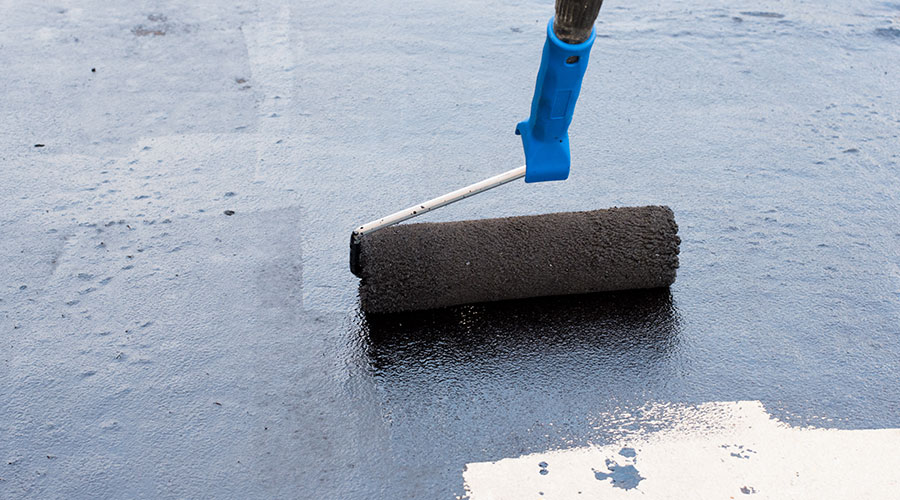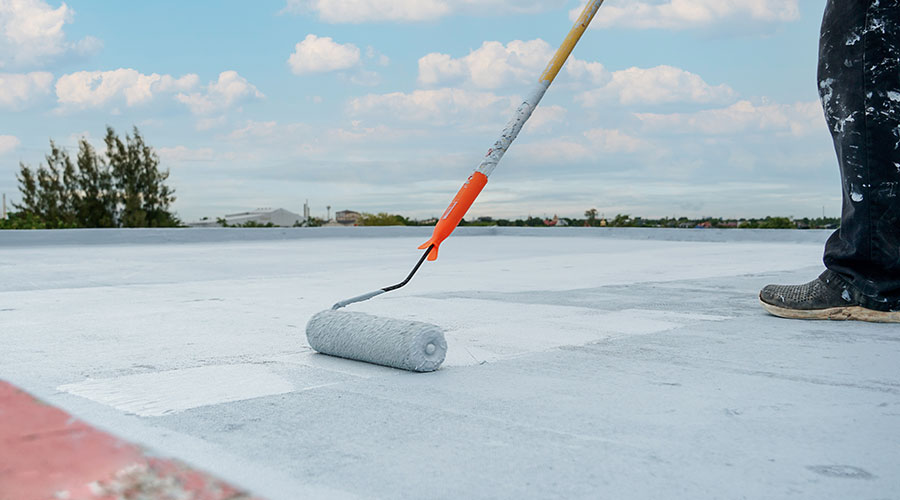Roof Failure: Effect and cause
Behind many common roof problems lie errors in design, materials and maintenance
The way a roof wears — the bumps and wrinkles it bears — can show a lot about why it is failing. Each type of failure — blisters, splits and punctures, to name a few — typically results from a specific cause. Poor design, for example, can lead to splits, and debris can cause punctures. Understanding the causes of the most common types of roof problems can help facility executives prevent the errors that too often shorten the life of the roof.
Ten Reasons Roofs Fail
1. Blisters. Bubble-like or long, thin raised areas on the roof are called blisters. Blisters are the most common roofing problem. They occur when a gas, usually water vapor, is trapped within the roofing system either between the plies or between the plies and the insulation. The heat of the sun during the day causes the gas to expand. The expansion of the gas creates a pressure within the system that pushes the plies apart, resulting in the blister.
Blisters would not occur if there were not some reason for moisture in the membrane. Two common ones are applying the roof to a damp substrate, as during a re-cover, and applying wet materials, such as felts, that have absorbed dew or rain on the edges. The moisture that causes blisters can often be traced back to another problem: improper storage of insulation, which allows water to soak through holes in shrink wrap or at the bottom of the stack where shrink wrap doesn’t cover. Moisture can also get into a roof installed in the presence of rain, snow or dew.
2. Open laps. Open laps in the field membrane, but especially in the flashings, are another problem. Open laps are just carelessness on the part of the installer. Usually it means that the installer has failed to apply adhesive to the entire lap. Sometimes it is caused in built-up and modified-bitumen systems when the bitumen is applied too cold. The laps appear to be closed, but open up as the roof ages.
In single-ply membranes, open laps are usually caused by improper surface preparation, such as adhering to a dirty membrane, heat welding at too cold of a temperature, not allowing the adhesive to dry properly or applying too much or too little adhesive.
3. Splitting. The most common splits occur when a metal accessory is flashed with a membrane material. As the temperature changes, metals and membranes expand and contract at very different rates. Because the membrane generally cannot move as much as the metal, it will eventually fatigue and crack when it is adhered to metal. This problem is not as common with single-ply membranes with better expansion and contraction capabilities, but it is common in asphalt and coal tar systems.
Splits occur frequently in expansion joints. Contractors rarely know how to properly terminate an expansion joint cover. They run it to the wall and stop it dead. Unfortunately, the movement in the building does not stop at the end of the expansion joint and, consequently, it rips open any attempt to seal that edge. Splits are also common at joints within the expansion joint cover itself.
Splits are not limited to flashings, however. As most roofs age, they become more brittle and less resilient. This means that they become less resistant to movement from common sources such as temperature changes, foot traffic and substrate movement. Because the roof cannot flex or stretch as well as it did when new, it cracks.
4. Punctures. The most preventable failure symptom, punctures usually occur because of carelessness on the part of people visiting the roof: HVAC technicians, window washers, painters, maintenance staff, smokers and tenants. Punctures can also occur because of debris left, blown or tossed on the roof. They may appear as tears or holes.
5. Penetrations. Another common failure location is penetrations. Of particular concern are pitch pans. There are three failures common to pitch pans: the sealer itself, the container in which it sits and the penetration to which the sealant is supposed to adhere. Almost all sealers used in pitch pans will crack eventually due to loss of plasticizer or aging. If the penetration is not stabilized, vibration or movement of the penetration can cause the sealant to crack around the penetration. If a penetration is not thoroughly cleaned of asphalt before installing pourable sealers, the sealer will not adhere to the penetration.
Other types of penetration flashings also can fail. Concrete curbs filled with sealer will crack if not fully supported underneath. Metal pans eventually rust and lose adhesion to the sealer. Rubber and plastic boots will deteriorate with ultraviolet radiation exposure. The sealant used at metal penetration flashings eventually deteriorates with exposure and may not seal to the penetration if the penetration has not been properly cleaned before installation. The penetration flashing may also leak if the wrong diameter flashing is used or the cover is not correctly installed.
6. Wrinkles. Wrinkles can occur both in the flashings and within the membrane itself. When there is differential movement between the roof deck and the perimeter, the flashings will wrinkle on a 45-degree angle. When a wrinkle reaches the edge of a membrane or flashing, the opening left at the end of the wrinkle is called a fishmouth because of its bass-mouth-like appearance. Depending on the ply in which the wrinkle occurred, the fishmouth can be a tunnel for water to get down into the building.
Wrinkles within the membrane will eventually fatigue and crack. Because they are raised above the surface of the roof, they are more prone to traffic damage, scuffing and surfacing loss than the rest of the roof.
7. Flashings. Flashings must be fastened at the top to prevent the membrane from slipping down the wall or curb, or to keep the membrane from creating a funnel into the building. A flashing normally terminates under a metal counterflashing. If it does, the counterflashing can create problems if the top is not properly sealed or the sealant has failed. If the metal counterflashing does not lap the membrane enough, it may fail to divert water from the flashing and instead funnel water into it.
8. Surfacings. Surfacings on membranes may provide protection from ultraviolet radiation and damage from traffic on the roof. They also may be a component of the fire rating of the roof. In the case of ballasted roofs, surfacings may be the only thing keeping the roof in place other than gravity. When the surfacing gets displaced or worn off, either from foot traffic, repair persons, wind, etc., this protection no longer applies.
9. Fasteners. In mechanically attached roofing systems, movement from wind will cause fasteners to rock back and forth with the gusts. Eventually, this movement causes the hole in the deck around the fastener to enlarge and the fastener to back out. The fastener heads can eventually puncture the membrane from below. But fastener back-out is not limited to single-ply membranes. It is also a common occurrence in metal roofing and in metal accessories on membrane roofs. In these cases, the backed-out fasteners leave holes where water can directly enter the building. This is an especially serious problem when a coping — the metal cap on the top of a parapet — is fastened through the top of the horizontal portion and not through the vertical flanges.
10. Abuse and Neglect. When it comes to mistreating a roof, the most common culprits are air conditioning and maintenance technicians, window washers, and sign installers. It is not unusual to see debris — ranging from screws and bits of sheet metal all the way up to empty refrigerant canisters and abandoned HVAC units — left on roofs after an air conditioning repair visit.
Small debris can cut into the roof if the debris is stepped on; large debris will work its way into the roof membrane during the hot months of the year. Sign installers routinely install conduit through the walls without properly sealing the penetrations. The water that gets into those penetrations works its way through the walls and into the building, disguised as a roof leak. Window washers and painters hang access equipment over the side of the roof, kick flashings and damage parapets, allowing leaks to occur. All of these groups of people can wreak havoc on base flashings, which get kicked, punctured with tools and machinery, and have mechanical equipment run up against them.
Owners contribute to the early demise of their own roofs by not properly maintaining them and failing to repair small problems, before they become big ones.
Staying Out of Trouble
Preventing problems begins with the design of the roof and choice of materials. The roof membrane chosen should reflect the characteristics of the building. For instance, if there will be a lot of foot traffic, the facility executive should plan on using a system that will be resistant to such damage. If the roof is wide open and there will be a great deal of thermal movement in the structure, a stretchable material such as an EPDM membrane is a better choice than a system that has limited elongation capabilities.
Details must be carefully thought out prior to installation. For example, a transition from a gravel stop to a parapet is a poor building design that must be compensated for in the roof design. A metal transition piece can help alleviate problems that occur as a result of differential movement and different directional movement between the gravel-stop portion and the parapet portion. Correcting slope-to-drain problems should be determined at the design stage.
Second, the roof must be properly installed. This means using dry materials and installing them according to the design details or manufacturer’s requirements. Expansion joints have to terminate in a way that the end of the joint will still compensate for building movement. This means that there should be no material crossing the joint — not gravel stops, not copings, not membrane and certainly not roofing cement — that cannot flex or move with the movement of the structure. Seams should be adhered.
Finally, the roof must be maintained. Roof access should be limited to only those who need to be there. Keep smokers, lunches and sunbathers off the roof. Not only will the cigarettes burn holes in the membrane, the foot traffic will damage the surface and cause the roof to fail prematurely. Owners should monitor the activity of sign installers and window washers to be sure that they are not damaging the roof as they work. New HVAC installations should be flashed not by the mechanical contractor but by a competent roofing contractor to be sure that the penetrations are sealed.
The roof itself should be examined twice a year and drains cleared and roof debris removed. All small problems like punctures and sealant failures should be addressed at this time to be sure that they are not causing problems that will lead to failure. A roof’s life is finite, but it doesn’t have to be short lived. Some common sense when designing the roof, some attention to detail when installing it, and some care when using it will maximize its life.
Contributing editor Karen Warseck, AIA, is president of Building Diagnostics Assoc., a Hollywood, Fla., architecture firm that specializes in building repair consulting.
Related Topics:











